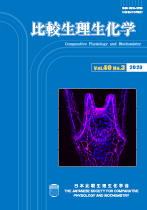
- |<
- <
- 1
- >
- >|
-
Yohey OGAWAArticle type: review-article
2023 Volume 40 Issue 3 Pages 128-136
Published: December 15, 2023
Released on J-STAGE: December 27, 2023
JOURNAL FREE ACCESSMore than 500 million years ago, the common ancestor of vertebrates acquired daylight vision with four types of cone cells and dim light vision with rod cells. Each photoreceptor cell has its unique phototransduction system and exhibits a characteristic cell morphology. These features are highly conserved across species, making it possible to identify photoreceptor cells in the retina in each species despite large evolutionary distances. However, photoreceptor cells in each species have been uniquely adapted to their specific light environment, and the number of photoreceptor cell types can vary greatly. This article explores the molecular basis of cross-species cell-type homology comparing the transcriptional mechanisms of photoreceptor differentiation in three species: zebrafish, house mouse, and human. Finally, I addressed the evolutionary shift from the four-cone type photoreceptor differentiation network, which would have been maintained in the common ancestor of fish and mammals, to the two-cone type mammalian network.
View full abstractDownload PDF (1459K) -
Shunsuke YAGUCHI, Junko YAGUCHIArticle type: review-article
2023 Volume 40 Issue 3 Pages 137-148
Published: December 15, 2023
Released on J-STAGE: December 27, 2023
JOURNAL FREE ACCESSSea urchins have been valuable tools in experimental biology for a long time. While they’ve made significant contributions to fields like developmental and cell biology, their role in neuroscience has been somewhat neglected. For years, there has been a lack of molecular information and a limited number of researchers interested in studying sea urchin neurobiology. As a result, there have been only sporadic reports on the morphology of sea urchin nervous systems from individual labs, setting neurobiology apart from mainstream sea urchin research. However, in the late 1990s and early 2000s, the development of molecular tools and the North American purple sea urchin genome project spurred an increase in neurobiological research within the sea urchin community. In recent years, this field has gained attention from an EvoDevo perspective as well. In this review, we focus on sea urchin larval nervous systems, presenting previously published papers on their development and function. We begin by briefly introducing sea urchins, which may not be familiar to this journal’s audience, and summarizing their evolutionary lineage, development, and research history. Then, we describe sea urchin larval nervous systems and detail their respective development processes. Additionally, we provide an overview of the information we’ve uncovered about their functionality. Finally, we discuss how insights from sea urchin larval neurobiology can be further developed from an evolutionary standpoint.
View full abstractDownload PDF (2433K) -
Hiroaki OTSUKA, Toshiyuki OKANOArticle type: review-article
2023 Volume 40 Issue 3 Pages 149-156
Published: December 15, 2023
Released on J-STAGE: December 27, 2023
JOURNAL FREE ACCESSAlthough humans do not sense the earth’s magnetic field (geomagnetic field) in daily lives, the magnetoreception ability has been demonstrated in a variety of species, including birds, reptiles, amphibians, fish, insects, and even bacteria. Animals, in particular, are thought to use the geomagnetic field for navigation during migration or homing. For description of animals’ magneto-responsibility, two types of mechanisms were proposed:“magnetite mechanisms”and“radical pair mechanisms”. The magnetite mechanism is a mechanical method that utilizes tiny magnetic particles, while the radical pair mechanism is a chemical method that utilizes light energy. Although the details of these mechanisms are still unknown, the study for elucidation of each mechanism have been proceeding in bacteria and birds, respectively. In this review, we introduce the organisms which possess the magnetoreception ability and the differences in the characteristics of the two magnetoreception mechanisms described above. In addition, our own research related to radical pair mechanisms and recent research trends is presented.
View full abstractDownload PDF (1714K)
- |<
- <
- 1
- >
- >|